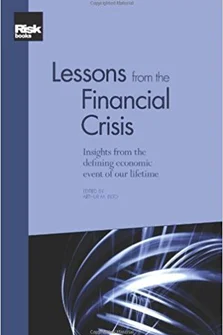The Quant Crunch Experience and the Future of Quantitative Investing
Bob Litterman
Introduction to 'Lessons from the Financial Crisis'
The Credit Crunch of 2007: What Went Wrong? Why? What Lessons Can be Learned?
Underwriting versus Economy: A New Approach to Decomposing Mortgage Losses
The Shadow Banking System and Hyman Minsky’s Economic Journey
The Collapse of the Icelandic Banking System
The Quant Crunch Experience and the Future of Quantitative Investing
No Margin for Error: The Impact of the Credit Crisis on Derivatives Markets
The Re-Emergence of Distressed Exchanges in Corporate Restructurings
Modelling Systemic and Sovereign Risks
Measuring and Managing Risk in Innovative Financial Instruments
Forecasting Extreme Risk of Equity Portfolios with Fundamental Factors
Limits of Implied Credit Correlation Metrics Before and During the Crisis
Another view on the pricing of MBSs, CMOs and CDOs of ABS
Pricing of Credit Derivatives with and without Counterparty and Collateral Adjustments
A Practical Guide to Monte Carlo CVA
The Endogenous Dynamics of Markets: Price Impact, Feedback Loops and Instabilities
Market Panics: Correlation Dynamics, Dispersion and Tails
Financial Complexity and Systemic Stability in Trading Markets
The Martingale Theory of Bubbles: Implications for the Valuation of Derivatives and Detecting Bubbles
Managing through a Crisis: Practical Insights and Lessons Learned for Quantitatively Managed Equity Portfolios
Active Risk Management: A Credit Investor’s Perspective
Investment Strategy Returns: Volatility, Asymmetry, Fat Tails and the Nature of Alpha
One of the more fascinating stories to come out of the investment world in recent years is that of quantitative investing. After a decades-long evolution, this approach to investing grew enormously over the 10 years prior to the events of July and August 2007. In the author’s view that is not the end of the story, but, rather, the beginning of a new chapter. Let us take a closer look.
To start with a definition, we like to think that quantitative asset management draws on the best knowledge from the academic theory of finance, which tells us that return should be commensurate with risk, to take advantage of systematic opportunities in the marketplace. Some risks are better than others, of course. Quantitative investors, just like all other investors, attempt to identify investments offering a premium that more than justifies the risk. A recent example occurred in early 2009 when the premium on credit risk seemed very high. The stock market was clearly on the mend by the end of April, but credit spreads remained quite wide. Many investors thought the nation faced a prolonged recession. Coming out of a severe crunch, credit spreads were wider than at almost any time in history
Copyright Infopro Digital Limited. All rights reserved.
As outlined in our terms and conditions, https://www.infopro-digital.com/terms-and-conditions/subscriptions/ (point 2.4), printing is limited to a single copy.
If you would like to purchase additional rights please email info@risk.net
Copyright Infopro Digital Limited. All rights reserved.
You may share this content using our article tools. As outlined in our terms and conditions, https://www.infopro-digital.com/terms-and-conditions/subscriptions/ (clause 2.4), an Authorised User may only make one copy of the materials for their own personal use. You must also comply with the restrictions in clause 2.5.
If you would like to purchase additional rights please email info@risk.net










